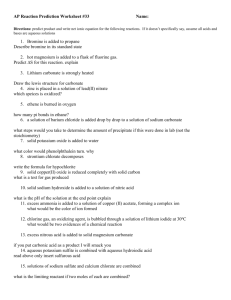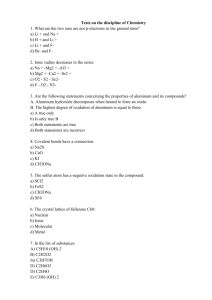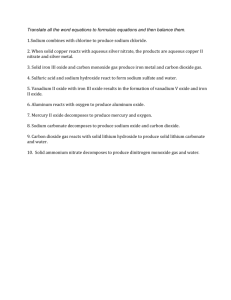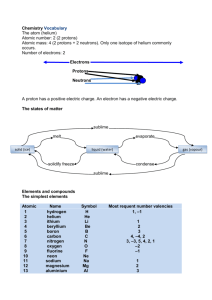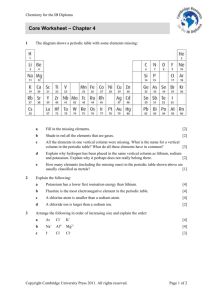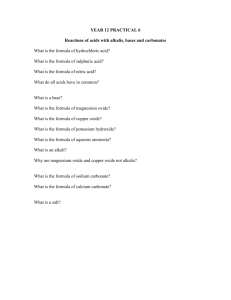CHEM PP I MS
advertisement
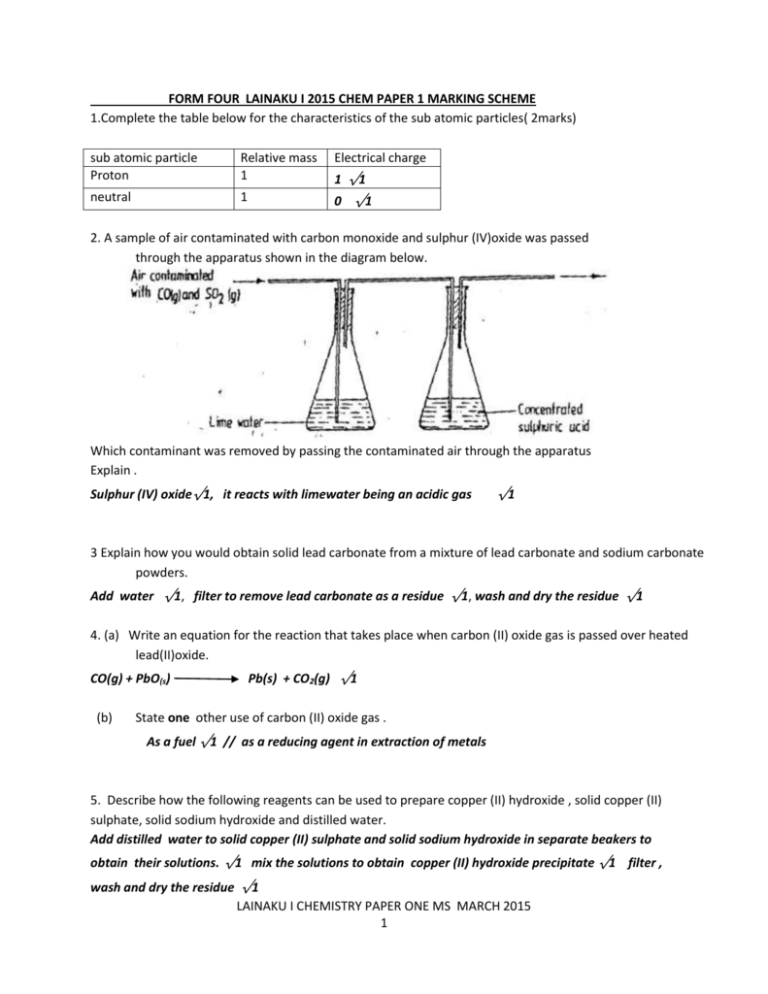
FORM FOUR LAINAKU I 2015 CHEM PAPER 1 MARKING SCHEME 1.Complete the table below for the characteristics of the sub atomic particles( 2marks) sub atomic particle Proton Relative mass 1 Electrical charge neutral 1 0 √1 1 √1 2. A sample of air contaminated with carbon monoxide and sulphur (IV)oxide was passed through the apparatus shown in the diagram below. Which contaminant was removed by passing the contaminated air through the apparatus Explain . Sulphur (IV) oxide√1, it reacts with limewater being an acidic gas √1 3 Explain how you would obtain solid lead carbonate from a mixture of lead carbonate and sodium carbonate powders. Add water √1, filter to remove lead carbonate as a residue √1, wash and dry the residue √1 4. (a) Write an equation for the reaction that takes place when carbon (II) oxide gas is passed over heated lead(II)oxide. CO(g) + PbO(s) (b) Pb(s) + CO2(g) √1 State one other use of carbon (II) oxide gas . As a fuel √1 // as a reducing agent in extraction of metals 5. Describe how the following reagents can be used to prepare copper (II) hydroxide , solid copper (II) sulphate, solid sodium hydroxide and distilled water. Add distilled water to solid copper (II) sulphate and solid sodium hydroxide in separate beakers to obtain their solutions. √1 mix the solutions to obtain copper (II) hydroxide precipitate √1 filter , wash and dry the residue √1 LAINAKU I CHEMISTRY PAPER ONE MS MARCH 2015 1 6. Aluminium metal is a good conductor and is used for overhead cables. State any other two properties that make aluminium suitable for this use . Has low density// it is light √1 Forms a protective oxide coating on its surface √1 7. A given volume of ozone, (O3) diffused from a certain apparatus in 96 seconds. Calculate the time taken by an equal volume of carbon (IV) oxide (CO2) to diffuse under the same conditions (O = 16.0, C = 12.0) R.M.M. of O 3 =48 𝑻𝑶𝟑 𝑻𝑪𝑶𝟐 𝟗𝟔 = 𝑻𝑪𝑶𝟐 8. R.M.M CO 2 =44 √1 = √𝑴𝑶𝟑/𝑴𝑪𝑶𝟐 √𝟒𝟖/𝟒𝟒 √1 =91.9 SECS (a) √1 What is meant by isomerism? compounds that have same molecular formula but different structural formula √1 (b) Draw and name two isomers of butane. H H H H H C H H C H C H H H C H BUTANE √1 half each H C C H 2-METHYLPROPANE √1 half each H C H H H 9 The table below shows the relative molecular masses and the boiling points of methane and water H C H Relative molecular mass Boiling point(oC) Methane 16 -161 Water 18 100 Explain why the boiling point of water is higher than that of methane. The molecules of water interact through strong hydrogen bonding √1 while molecules of methane have weak van der waals forces√1 LAINAKU I CHEMISTRY PAPER ONE MS MARCH 2015 2 10. Air was passed through several reagents as shown in the flow chart below ` Escaping gases AIR Concentrated KOH Excess heated Excess heated solution Copper turnings Mg powder (a) Write an equation for the reaction, which takes place in chamber with magnesium powder 3Mg (s) + N2 (g) Mg3N2(s) √1 (b) Name one gas, which escapes from the chamber containing magnesium powder. Give a reason for your answer. b) Argon // Neon (name of a noble gas) √1 Because they are inert and not likely to have reacted with any of the reagents. √1 11. (a) Other than the enthalpy of combustion, state one factor which should be considered when choosing a fuel. Ease of transportation//availability//cost//environmental effects//ease of storage √1 (b) The molar enthalpies of neutralization for dilute hydrochloric acid and dilute nitric (V) acid are 57.2KJ/mol while that of ethanoic acid is -55.2kJ/mol. Explain this observation. The molar enthalpy of neutralization of ethanoic acid is lower√1 because it ionizes partially so some heat energy √1is used to ionize it. 12. a) Study the scheme below and answer the questions that follow. White Solid X Heat Yellow residue When hot Brown gas + Oxygen LAINAKU I CHEMISTRY PAPER ONE MS MARCH 2015 3 Zinc nitrate √1 (a) Name (i) Solid X (ii) The yellow residue Zinc (II) oxide √1 (b) Write an equation for the decomposition of the yellow solid 2Zn(NO 3 ) 2(S ) 2 ZnO (S) + 4NO 2 (g) + O2(g) √1 13. Ammonia can be converted to nitrogen ( II ) oxide as shown in the equation below 4NH3 (g) + 5O2 (g) 4NO (g) + 6H2O (I) √1 Energy Catalyzed Reactants Products Reaction path (a) Explain how an increase in temperature would affect the yield of nitrogen (II)oxide increase in temperature would lower the yield of Nitrogen √1, this is because the reaction is exothermic and equilibrium shift to the left. √1 b) On the energy level diagram above sketch, the energy level diagram that would be obtained if the reaction is carried out in the presence of platinum catalyst. LAINAKU I CHEMISTRY PAPER ONE MS MARCH 2015 4 14. Use the information below to answer the questions that follow: Zn2+(aq) + 2ezn(s) Al3+(aq) + 3e- Fe2+ (aq) + 2e- Al (s) -0.76 V -1.66 V Fe(s) -0.44 V a). Calculate the E value for the electrochemical cell below Al3+ (aq) Al(s) …(a) Al3+(aq) Al(s) Fe(s) Fe2+(aq) Fe(s) = EθR ed − EMF Fe2+(aq) EθOx = (-0.44) – (-1.66) √1 = 1.22V √1 (b) Give a reason why aluminium metal would protect iron from rusting better than zinc metal. - Has less negative E value √1 - It is on the left cell rep// aluminium is more reactive than iron 15. The grid below shows part of a periodic table. The letters do not represent the actual symbols of the elements G H F (i) a) J I Select the: element which has the largest atomic radius. (ii) F √1 Most reactive non-metal . I √1 b) Show on the grid the position of the element J which forms J2- ions with electronic configuration 2, 8, 8. (1mk) 16. A hydrocarbon slowly decolorizes bromine gas in the presence of sunlight but does not decolourise acidified potassium manganate (VII). (i) Name the homologous series to which the hydrocarbon belongs . alkane √1 LAINAKU I CHEMISTRY PAPER ONE MS MARCH 2015 5 (ii) Give an example of a member of the homologous series named in (i) above. Methane/Ethane/Propane/ Butane /Pentane √1 17. Atoms of element X exists as 14 𝑋 and 6 //any alkane 12 𝑋 6 (a) What name is given to the two types of atoms. Isotope √1 (b) Use dot (∙) and cross (x) diagrams to illustrate the atomic structure of Nucleus composition 14 𝑋 6 √1 Ec 2.4 √1 18. When dilute nitric acid was added to a sample of solid C, a colourless gas that formed a white a white precipitate with limewater was produced. When another sample of solid C was heated strongly in a dry test – tube, there was no observable change. (a ) identify the cation and anion in solid C CATION Na + // sodium √1 ANION CO3 2- // Carbonate √1 19 Complete the table below by inserting the missing information in the space provided. Name of polymer Name of monomer One use of the polymer ethene Polyethene √1 Squeeze- bottles // √1 buckets//bowls// piping//coating for cables//plastic bags 20. In an experiment, soap solution was added to three separate samples of water. The table below shows the volumes of soap solution required to form lather with 100cm3 of each sample of water before and after boiling. Sample I Sample II Sample III 3 Volume of soap before water is boiled (cm ) 27.0 3.0 10.6 3 Volume of soap after water is boiled cm ) 27.0 3.0 3.0 (a) Which water sample is likely to be soft? Explain. Sample II √1 (b) it lather with a small amount of soap √1 Name the type of water hardness in sample III Temporary hardness √1 21. The reaction of ethane with chlorine gas gave a compound of formula C2 H 5Cl. LAINAKU I CHEMISTRY PAPER ONE MS MARCH 2015 6 a) What condition is necessary for the above reaction to take place? b) u. v radiation // sunlight √1 Draw the structural formulae of the compound C2 H 5Cl. and name it. H H H C H C Cl √1 chloroethane √1 H 22 .Soot is one of the environmental pollutants . (i) Explain the term pollutant. Harmful substance released into the environment √1 (ii) State how soot is formed from hydrocarbons. Soot is formed when hydrocarbons burns in a limited supply of oxygen √1 // incomplete combustion 23. In an experiment, sulphur (Iv) oxide gas was bubbled into water followed by chlorine gas. The resulting colorless solution gave a white precipitate when mixed with a acidified barium chloride solution. Explain these observations. SO 2 reacts with water to form SO2-3/ sulphurous acid √1 which then is oxidized by chlorine to SO2-4/ sulphur ic (VI)acid (1). SO2-4 reacts with Ba2+ to form insoluble BaSO4(l) √1 24. A compound has an empirical formula, C 3H6 O and a relative formula mass of 116. Determine its molecular formula (H = 1.0, C = 12.0, O = 16.0) E F M = 12X3+ 1X6 +16X1 = 58 58 n = 116 √1 n 25. = 2 MF is ( C3 H 6 O ) X 2 √1 = C 6 H 12 O2 √1 The table below gives three experiments on the reaction of excess hydrochloric acid and 0.5g of calcium carbonate done under different conditions. In each the volume of gas was recorded at different time intervals. Experiment Form of Zinc Sulphuric acid solution I Powder 0.8m II Powder 1.0m III Chips 0.8m LAINAKU I CHEMISTRY PAPER ONE MS MARCH 2015 7 On the axis below draw and label the three curves that could be obtained from such results. (3mks) Powder 1.0 M Powder 0.8M Chips 26. Crystals of sodium carbonate decahydrate (Na 2 CO 3 . 10 H days. (i) State what was observed. 2 O ) were exposed to air for about four A white powder was formed √1 (ii) Name the process that took place. Efflorescence √1 (ii) Write an equation for the reaction that occurred. Na 2 CO 3 .10 H2 O Na 2 CO 3 . H2 O(s ) (s ) + 9 H2 O(l) √1 27. Explain why molten calcium chloride conducts electricity while silicon (IV) oxide does not. molten calcium chloride contains delocalized ions which carry charge√1 but silicon (IV) oxide does not √1 28. Calculate the mass of sodium oxide, Na2 O , formed when 3.45 g of sodium burns in air. (Na =23, O=16). 4 Na( s ) + O2(g ) 2Na 92 g 2 O (s ) √1 108 g 𝟑.𝟒𝟓 𝟗𝟐 3.45 g x 108 √1 = 4.05 g √1 29. T he table below gives the first ionization energy of three elements. Element 1st ionization energy(kJ/mol) A 496 B 419 C 520 (i) define the term first ionization energy. First ionization energy is the minimum amount of energy required to removed the first electron From a gaseous atom √1 (ii) select the element that is the most reactive. Explain. B √1 it has the least ionization energy therefore loses electrons most readily √1 LAINAKU I CHEMISTRY PAPER ONE MS MARCH 2015 8 30. State the colour of the indicators in the solutions given in the table below: Colour in Indicator Acid Base Litmus Red Blue √1 Methyl orange Orange Yellow √1 Phenolphthalein Colourless Pink √1 LAINAKU I CHEMISTRY PAPER ONE MS MARCH 2015 9
